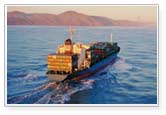|
| |
| |
The transportation of goods is an activity bringing in profits for both the owners of the transported goods and the service provider. This is always the case, regardless of the means and methods of transportation.
Although it may seem obvious, it is worthwhile to point out that the demand for transportation arises and is supported by certain levels of goods trading, whether they are manufactures or not. In other words, the amount of transport required will depend on the trade volumes. |
 |
|
| |
If the trade demand is higher than the hold offer -inflexible in the short term- transportation prices will increase until they reach a ceiling price. That ceiling price is the price the dealer will be willing to pay for the transportation of goods and the base price from which he/she does not get any profit from international transactions.
We assume that market cycles (ups and downs) do not happen by chance, or on somebody's whim. On the contrary, they result from a set of factors –complex at their source and diverse in terms of interest and expression. And that is the reason why markets do not reflect transparent or simple situations; in contrast, they show the conflicts of interest between different sectors –private or public- in their struggle to get and maximize their benefits .
|
|
| |
 Argentine Foreign Trade Argentine Foreign Trade
|
|
| |
 |
In the case of the international transportation of goods, trade flows are shown by the volumes of exported and imported goods.
The maritime transportation of (export or import) raw materials is far more sensitive to the demand fluctuations in the international market than the maritime transportation of manufactures and semimanufactures (usually containerized and based on regular and stable transactions over time).
|
We might also agree on the fact that, due to their physical characteristics, nature, and demand cycles, certain goods are subject to maritime transportation while others, for the opposite reasons, are subject to air or ground transportation –although the latter are also influenced by issues such as geography and proximity between producer and consumer markets.
Over the past years, Argentine foreign trade showed different behaviors. There were periods of growth and others with a notorious plateau effect. We may conclude that, to a certain extent, foreign trade results depict the economic situation of a country.
As shown by statistics, the geographic distribution of the Argentine foreign trade points out Mercosur as the area with the highest exchange level (26.3%). Since Mercosur is a block made up of neighboring countries, we may conclude that there is an intensive use of road, river, and maritime methods to transport bulk cargo. Moreover, it is evidenced that a significant part of trade is conducted using the last method for the transportation of general cargo (manufactures and semimanufactures) between Argentina and Brazil. In the case of NAFTA, the trade with Argentina holds the second position, with 24.2%, approximately. Obviously, the USA leads Argentina's purchases and sales, though the trade with Mexico is significantly increasing.
The main connection with this market is via maritime transportation and the ports located on the American East Coast and the Gulf of Mexico.
In connection with transportation, once again maritime transportation takes the lion's share -which seems quite logical if we take into account the impact of freights on the costs of transported goods.
It is worthwhile to point out that the import volume from this market is practically similar to the purchases made by Argentina in Mercosur (33.17% versus 33.67%.)
The trade between the European Union and Argentina comes in the third place, with 19.5% approximately. There are two traditional routes for general cargo: the North Sea (with larger volumes) and the Mediterranean Sea. In both routes, the shipping companies provide top quality services with a regular frequency.
The service level might be affected by the falling demand for imports, which will undoubtedly impact the rates paid by exports -mainly imports related to livestock and agriculture manufactures and, to a lesser extent, industrial exports. As to traditional product exports, both product prices and the transport rates depend on market fluctuations.
|
|
|
| |
 Middle and Far East Middle and Far East
|
|
| |
Thinking in terms of transportation, we found out some data that must be considered: the addition of the trade volumes with countries from Middle and Far East (including those from ASEAN and others located in the same route) amounts to 6.17 billion US dollars, placing this region and the maritime services related to the freight market right below NAFTA.
It is certain that the trade volumes in this route will significantly increase in the short and mid term.
|
|
The reasons for this: increased trade between Mercosur countries with China, India, and other nations of South-East Asia.
At present, the traffic is managed properly, and the emergence of new business for exporters in the region requires higher service frequencies. |
|
|
| |
 Conclusão Conclusão
|
|
| |
The foreign trade growth evidenced in the countries of this region will require, in the near future, greater care on the part of international shipping companies, mainly because we are facing a new profile and orientation of trade volumes.
The so-called "South-South" route has begun to generate trade volumes which will most likely place it among the most important routes in the next five years.
It is estimated that the traffic to and from Europe will increase after the agreement between Mercosur and the European Union. Likewise, it is yet to be seen to what extent the addition of ten new members to EU will reduce trade.
The ports located in the region will have to adjust themselves in order to include the qualitative changes foreseen in both trade and shipping services. Some ports will operate as feeders while others will be regional hubs to facilitate transshipping. Be patient and you will see it. |
|
| |
|
|
|
|
|
|
|
